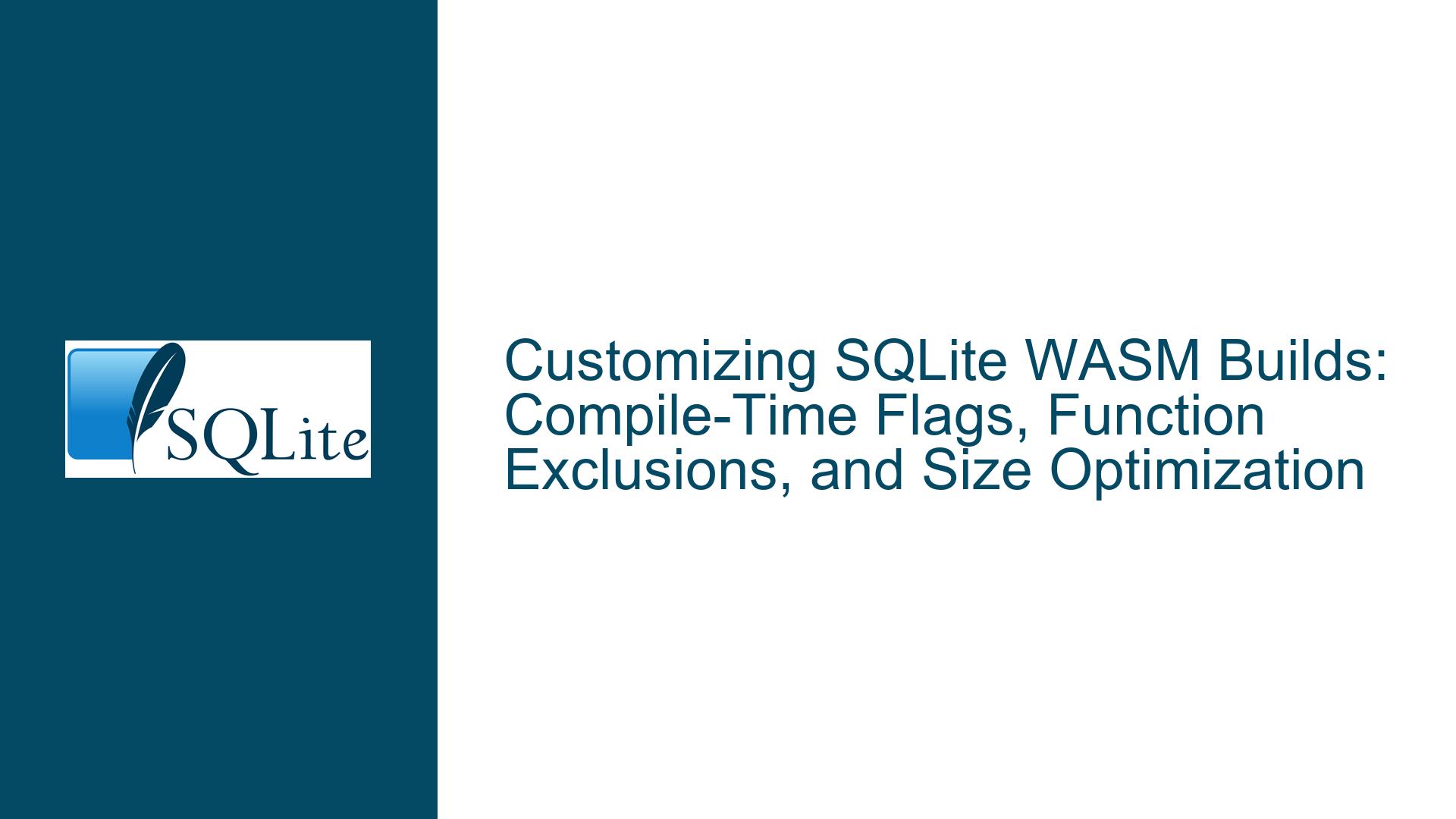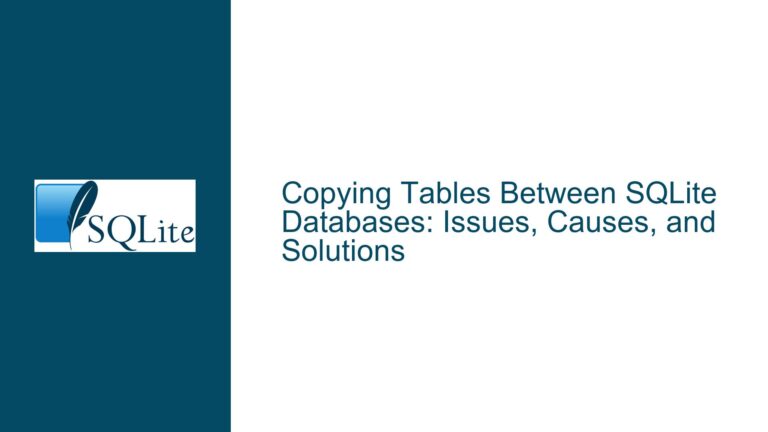Customizing SQLite WASM Builds: Compile-Time Flags, Function Exclusions, and Size Optimization
Understanding Compile-Time Flags and Their Behavior in SQLite WASM Builds
When working with SQLite in a WebAssembly (WASM) environment, one of the first challenges developers encounter is the behavior of compile-time flags. These flags, such as ENABLE_FTS4 and ENABLE_OFFSET_SQL_FUNC, are often enabled by default in the sqlite3-wasm.c file. The issue arises when developers attempt to disable these flags using the -D[flag name]=0 directive during compilation. Despite this, the features associated with these flags remain enabled, leading to confusion and potential bloat in the final WASM binary.
The root cause of this behavior lies in the #ifndef preprocessor directives within the sqlite3-wasm.c file. These directives check whether a flag is defined, and if not, they define it with a default value. This means that even if you attempt to disable a flag using -D[flag name]=0, the #ifndef directive will still define the flag, effectively overriding your attempt to disable it. To truly disable these features, you must manually comment out the corresponding #ifndef lines in the source code. This approach, while effective, is not ideal for maintainability, especially when dealing with multiple custom builds.
The situation is further complicated by the fact that the SQLite team has not yet focused on making these flags easily customizable for WASM builds. The primary reason for this is that the WASM build process is relatively new, and the team has prioritized stability and functionality over customization. As a result, developers looking to create highly customized builds must be prepared to dive into the source code and make manual adjustments.
Exploring the Impact of Recommended Compile-Time Options on WASM Builds
SQLite provides a set of recommended compile-time options that can significantly impact the performance and size of the resulting binary. These options, such as OMIT_DECLTYPE, OMIT_PROGRESS_CALLBACK, OMIT_AUTOINIT, and LIKE_DOESNT_MATCH_BLOBS, are designed to exclude certain features from the build, thereby reducing the binary size and potentially improving performance.
However, the challenge with these options is that they are not fully tested for WASM builds. The SQLite team primarily tests the default set of options used in the precompiled WASM binaries they distribute. This means that while these options may work as expected in traditional builds, their behavior in a WASM environment is less predictable. For example, some OMIT flags may remove functions that are expected by the JavaScript (JS) code that interfaces with the WASM module. If the JS code attempts to bind to a function that has been excluded, it will throw an error during module initialization.
This lack of testing for custom builds is a significant consideration for developers looking to optimize their WASM binaries. While the potential benefits of using these flags are clear, the risks associated with untested configurations must be weighed carefully. Developers should be prepared to thoroughly test their builds and potentially modify the JS code to account for missing functions.
Strategies for Reducing WASM Binary Size Through Function Exclusions
One of the most effective ways to reduce the size of a SQLite WASM binary is to exclude unnecessary functions from the build. This approach is particularly relevant for developers who are targeting specific use cases, such as local document search, where only a subset of SQLite’s functionality is required. By excluding functions that are not needed, developers can significantly reduce the size of the final binary, leading to faster load times and reduced memory usage.
The process of excluding functions begins with identifying the core functionality required for the application. For example, a minimal build might only require the open_v2, exec, and basic memory management utilities. Once the required functions are identified, developers can use the emcc (Emscripten Compiler) to exclude unnecessary functions from the build. This is typically done by specifying the functions to be excluded in the emcc command line or by modifying the build configuration.
However, this approach is not without its challenges. The SQLite WASM build process is not currently designed to support fine-grained function exclusions. While it is possible to exclude functions manually, doing so requires a deep understanding of the build process and may involve modifying the source code. Additionally, the SQLite team has expressed concerns about the maintainability of highly customized builds. Given the limited demand for such builds, the team has prioritized stability and ease of use over customization.
Despite these challenges, developers who are willing to invest the time and effort can achieve significant size reductions. For example, one developer reported reducing their WASM binary size to approximately 550kb by excluding unnecessary functions and optimizing the build process. This represents a substantial reduction from the default build size and demonstrates the potential benefits of this approach.
Balancing Customization and Maintainability in SQLite WASM Builds
The desire for highly customized SQLite WASM builds must be balanced against the need for maintainability and stability. While it is technically possible to create builds that exclude all but the most essential functions, doing so introduces significant complexity into the build process. This complexity can make it difficult to maintain the build over time, especially as new versions of SQLite are released.
The SQLite team has acknowledged the potential benefits of more customizable builds but has also expressed concerns about the additional maintenance burden. Given the limited demand for highly customized builds, the team has opted to focus on providing a stable and functional default build. However, they have also indicated a willingness to work with developers to identify and implement reasonable levels of customization.
One potential approach to balancing customization and maintainability is to define a set of "chunks" or modules that can be included or excluded from the build. For example, a minimal build might include only the core SQLite functionality, while additional modules could provide support for features such as virtual tables, custom functions, and session management. This approach would allow developers to create builds that are tailored to their specific needs without requiring fine-grained control over individual functions.
The Role of wasm_enum_json and Its Implications for Build Customization
The wasm_enum_json function plays a crucial role in the SQLite WASM build process by generating a JSON object that contains various constants and configuration options. This function is used to ensure that the JS code has access to the correct values for things like struct sizes and offsets, which can vary depending on the build configuration.
While the current implementation of wasm_enum_json is effective, it has been criticized for being somewhat roundabout. The function generates the JSON object at runtime, which adds a small amount of overhead to the build process. Some developers have suggested that it would be more efficient to generate the JSON object during development and include it as a static file in the release build.
However, this approach has its own challenges. Generating the JSON object during development would require additional tooling and could introduce potential issues with platform-specific differences. For example, a 64-bit WASM build might generate different values than a 32-bit build, leading to inconsistencies between development and production environments. By generating the JSON object at runtime, the current approach ensures that the correct values are always used, regardless of the build configuration.
Evaluating the Practical Impact of WASM Binary Size on Real-World Applications
The size of the SQLite WASM binary is a topic of ongoing debate among developers. While some argue that reducing the binary size is essential for performance and user experience, others believe that the current size is acceptable given the capabilities provided by SQLite.
The reality is that the impact of binary size on real-world applications depends on a variety of factors, including the target audience, the network conditions, and the specific use case. For example, a 300kb reduction in binary size might be insignificant for users with high-speed internet connections but could make a significant difference for users in areas with limited bandwidth.
That said, modern web development practices, such as lazy loading and asynchronous loading, can mitigate the impact of binary size on page load times. By loading the SQLite WASM binary separately from the main page content, developers can ensure that the binary does not block the rendering of the page. Additionally, the use of modern compression techniques can further reduce the effective size of the binary.
Ultimately, the decision to invest time and effort into reducing the SQLite WASM binary size should be based on the specific needs of the application and the target audience. While there are clear benefits to optimizing the binary size, these benefits must be weighed against the potential costs in terms of development time and complexity.
Conclusion: Navigating the Complexities of SQLite WASM Build Customization
Customizing SQLite WASM builds is a complex and nuanced process that requires a deep understanding of both the SQLite codebase and the WASM build process. Developers looking to create highly optimized builds must be prepared to navigate a variety of challenges, including the behavior of compile-time flags, the impact of recommended compile-time options, and the trade-offs between customization and maintainability.
While the SQLite team has prioritized stability and ease of use over customization, they have also expressed a willingness to work with developers to identify and implement reasonable levels of customization. By carefully considering the specific needs of their application and the potential impact of binary size on their target audience, developers can make informed decisions about how to approach SQLite WASM build customization.
In the end, the goal is to strike a balance between performance, functionality, and maintainability. By doing so, developers can create SQLite WASM builds that are both efficient and reliable, providing a solid foundation for a wide range of web-based applications.






